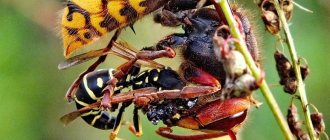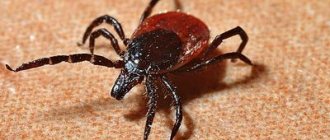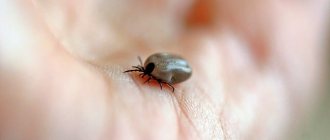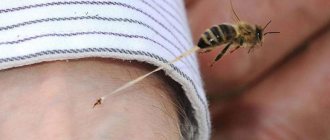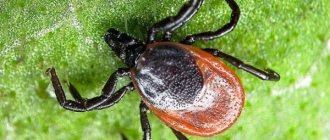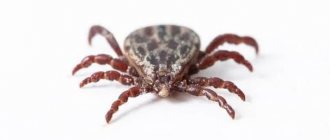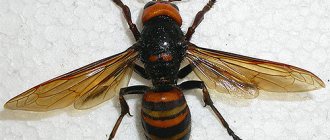Ticks of the genus Ixodes are small, blood-sucking parasites. Externally, the tick bears some resemblance to a spider. During the warm season, ixodid ticks become more active and begin to prey on people and warm-blooded animals.
As the tick attaches itself to its victim, it begins to increase in size and become grayish or bluish.
Blood-sucking insects move rather slowly, but are able to feel the heat from a potential victim at a distance of 10 meters.
Ticks bite absolutely painlessly, thanks to the injection of a specific secretion containing enzymes. But the danger of the ixodid tick lies not in the bite itself, but in the fact that the parasites are carriers of a large number of dangerous infectious pathologies.
What to do if your dog is bitten by a tick
Some diseases do not develop immediately, but are chronic in nature.
For example, piroplasmosis, anaplasmosis and Lyme disease. Their symptoms may appear after some time, when it is too late to treat the dog. Therefore, you need to remove ticks from your skin immediately after a walk. What to do if your dog is bitten by a tick:
- Using special tweezers, remove the tick from the skin, being careful not to damage it. Ideally, the parasite should be removed by a veterinarian. But if you can’t urgently take your dog to the clinic, you’ll have to master this art yourself. Below we will give detailed instructions on how to do this correctly.
- Submit the tick to a laboratory for analysis to ensure that it is not a carrier of dangerous infections. The parasite must be placed in a clean and sealed plastic bag. It is better to find out the addresses of the clinics in advance: not every veterinary laboratory does such an analysis.
- Monitor your dog’s well-being closely for 2–3 weeks.
Find a veterinarian
Most often, ticks “settle” in secluded places: on the face, in the armpits, on the stomach and in the genital area. A newly attached tick looks like a small black spider. When the parasite drinks blood, it looks like a large black-brown pea. Take a good look at the potential mite - it could be a mole or papilloma.
Dogs at risk include:
- with short hair - Chihuahuas, Rottweilers
- with a thin undercoat - Yorkshire terriers
- hunting dogs that spend a lot of time in the forest
It is also not easy to spot ticks in thick fur, so owners of huskies, Samoyeds, Spitz dogs and other owners of luxurious fur coats must use anti-tick medications. But the presence of such treatment in no way frees you from daily inspection.
What you should never do:
- Lubricate the tick with oil
in the hope that it will suffocate. In fact, the parasite will only dig deeper into the skin and inject saliva containing harmful microorganisms into the animal’s body. - Douse the tick with alcohol
, kerosene or vodka. Yes, these remedies will help kill the parasite - it will literally “tear it apart.” But at the same time, harmful substances from his digestive system will get onto the dog’s skin. - Squeeze the parasite
with your hands, pull it out with your nails, or use tweezers. If you damage the body or leave the head of the tick in the wound, your dog may become infected.
Diagnosis of piroplasmosis
The diagnosis of piroplasmosis should be made only by a veterinary specialist, using a number of laboratory tests. First of all, the doctor will conduct a clinical examination of the sick dog, but since the symptoms of the disease may be weak or absent altogether, the following methods are prescribed:
- Clinical and biochemical blood test to detect Babesia in erythrocytes.
- Polymer chain reaction for parasite antigen detection.
- Urine analysis to determine the color of biological fluid and the presence of hemoglobin in urine.
- Examination of an ixodid tick removed from a dog’s body for the presence of parasites in the bloodsucker.
In some cases, repeated diagnosis may be required, since in the initial stages of the disease the presence of Babesia in the blood cannot be established.
How to remove a tick from a dog
Removing a tick from a dog at home is difficult, but possible. To do this you will need a special twister. The plastic instrument does not compress the body of the parasite and thereby prevents its saliva from entering the animal’s blood. With its help, you can remove the entire tick, including the head. You need to do it like this:
- Select the twister according to the size of the tick. Usually these tools are sold in sets - larger and smaller.
- Spread the fur as far apart as possible.
- Secure the tick in the twister slot so that it supports the parasite.
- Lift the tool slightly and turn it 2-3 turns, as if you want to unscrew the parasite from the dog’s body.
- When the tick falls off, disinfect the wound.
Wear gloves and wash your hands before and immediately after the procedure - ticks are also dangerous for humans.
Biology of the pathogen
Piroplasmosis is provoked by Babesia, which replace two hosts during the entire development cycle. The first are ticks. Infection occurs through the bite of a sick animal. Dogs become infected after eating a sick parasite.
Babesia enter the bloodstream and begin to actively divide. Single-celled microorganisms develop in red blood cells and feed on hemoglobin. After some time, they begin to transform, getting into the stomach.
On a note!
In ticks, parasites are contained in large numbers in the saliva, so when bitten they enter the blood en masse. Babesiosis in dogs develops rapidly; the clinical picture directly depends on the animal’s body’s defenses.
Dog after a tick bite: symptoms of disease
For 2 to 3 weeks after you remove the tick from your dog, monitor your dog closely for changes in behavior. The first symptoms may appear within a week, but sometimes the disease lurks for 15–20 days.
Nadezhda Martyanova veterinarian
4,98 66
Open profile
For piroplasmosis, the incubation period lasts seven days. Therefore, after a bite, you need to monitor the animal and if even slight lethargy appears, immediately consult a doctor, take a clinical blood test and do a test for infection. In any case, I advise you not to panic or self-medicate under any circumstances.
Alarming symptoms may also include:
- weakness in hind limbs
- refusal to eat
- diarrhea
- yellowness and pallor of mucous membranes
- shortness of breath or rapid breathing
- temperature rise to 40–42 degrees
- dark, brown, orange urine
- pain when moving, arthritis
If you notice at least some of the symptoms, you should see a veterinarian. The longer a dog goes without veterinary care, the worse the prognosis.
Treatment
The professional approach to the treatment of piroplasmosis in the Russian Federation and abroad is different.
The European approach is to inject an imidocarb-based drug if symptoms of piroplasmosis occur. The dog is monitored for 2 weeks. If your pet is feeling good, there is no need to do anything. Otherwise, the injection is repeated. Imidocarb protects the dog from subsequent arthropod attacks.
If the first injection coincides with darkening of the urine, an antimicrobial drug containing Doxycycline, Azithromycin or erythromycin is prescribed. Antibiotics destroy synergistic microflora. After completing the course, the dog is temporarily transferred to veterinary food with prebiotics to restore digestion.
In Russia, a different treatment regimen has been adopted. Diminazene aceturate derivatives are mainly used. To maintain the function of the liver, kidneys, and heart, maintenance therapy is carried out through droppers. Antibiotics are widely used. Veterinarians practice additional injections of antiprotozoal drugs. The liver suffers. The situation is corrected with hepatoprotectors.
I recommend using Hill's l/d high-calorie and low-protein veterinary nutrition for the treatment of liver pathologies to restore digestive functions.
Despite the dissimilarity of symptoms and pathogens, the treatment regimen for bartonellosis, borreliosis and ehrlichiosis is approximately the same. In all situations, a course of antibiotic therapy with Doxycycline is used.
If the causative agent of the disease is protozoan microorganisms, an injection of Imidocarb is given. General strengthening agents, hepatoprotectors, and B vitamins are used.
To restore digestive functions, use Hill's l/d or Royal Canin Hepatic medicinal food.
Effective tick repellents for dogs
Unfortunately, there is no vaccine against diseases that a tick can infect a dog with. And you can protect your pet only with the help of special means that repel or paralyze parasites.
The most effective medications, says veterinarian Daria Tarasova, are isoxazolines in tablet form: Bravecto, Simparica, NexgarD. But for them to work, it is important to meet several conditions:
- Check the expiration date of the drug.
- Read the instructions carefully.
- Calculate the required amount of the drug based on the dog's weight.
- Do not divide the dose under any circumstances: the pet must eat the required number of tablets only as a whole.
Daria Tarasova veterinarian
5,0 183
Open profile
Collars are not very effective for large and fluffy dogs, since the active substance may not reach the rear parts of the body. In addition, the owners themselves very often violate the instructions for use: they put on the collar only before going outside. Or they leave it dangling around the neck without tightening it so that it adheres to the skin. Drops on the withers may be ineffective for the same reasons.
“Simparica”, “NexgarD”, “Bravecto” - anti-tick tablets for dogs
The active ingredient in such tablets blocks the tick's nervous system. Even if he bites an animal, he will not have time to transmit harmful microorganisms to it. Over time, the parasite will dry out and fall off on its own - provided that there is a sufficient concentration of the active substance in the dog's blood.
Pros:
- In addition to ixodid ticks, it fights fleas, ear mites, subcutaneous mites and scabies.
- Dogs readily eat these tablets as a treat. They can be mixed with food or given by hand.
- Suitable for pregnant and lactating dogs.
- Suitable for breeds with gene mutations.
Minuses:
- Do not divide or break tablets. Therefore, be sure to choose a dosage that is appropriate for your dog’s weight.
- As with any medicine, there is a risk of allergic reactions and intestinal upset.
| "Simparica" | "Nexgard" | "Bravecto" | |
| Active substance | Saloraner | Afoxolaner | Fluralaner |
| Dog weight | From 1.3 kg | From 2 kg | From 2 kg |
| Validity | 12 weeks | 1 month | 12 weeks |
“Simparika” should be chosen for small puppies weighing from 1.3 kg. “NexgarD” is suitable for those who want to “treat” their dog from all parasites at once: the drug is an anthelmintic, so with one tablet you treat the dog against ticks, fleas, and helminths. “Bravecto” is for those who like to give one tablet and forget about treatment for 4 months.
Anti-tick collar
A collar is a good choice as long as the dog can wear it all the time. It contains acaricidal preparations, which are gradually distributed over the surface of the skin and coat. The most famous brands are Foresto, Kiltix and Bars.
Pros:
- One collar is enough for the whole season, for example, “Foresto” is designed for 8 months.
- Suitable for dogs with sensitive digestion.
- There are collars that also protect against fleas and helminths.
- Allergic reactions, according to manufacturers, occur extremely rarely.
Minuses:
- It does not act instantly - maximum effectiveness occurs within 24 hours.
- The tick collar must be worn continuously.
- Collars are not suitable for puppies under 7 weeks of age.
Drops on the withers against ticks
There are several mechanisms for how spot-on drops work on the withers:
- The drug is absorbed into the skin, enters the blood, and then is excreted along with sweat.
- The drug does not enter the blood, but is distributed over the skin. For example, Bars operates on this principle.
The effect of the drops also varies: some create the sensation of “burning legs” on the tick, and it falls off. Others poison it after the bite.
Pros:
- Suitable for pets with a weak gastrointestinal tract.
Minuses:
- The treatment needs to be done frequently: the drops last for up to three weeks.
- Some drugs are not waterproof and stop working after the first rain or wash.
- If your pet licks drops of ticks, he may be poisoned. Therefore, it is important to apply the drops correctly: on the withers, in a place inaccessible to the dog.
What about folk remedies?
The effectiveness of folk remedies has not been proven. And some of them even put the dog’s life at risk. For example, garlic is dangerous for both ticks and pets. Natural repellents like wormwood tincture and tar soap can only be used as an addition to standard treatment - this is an indirect measure to prevent and repel ticks.
Possible complications
Consequences:
- lung enlargement;
- liver damage;
- ischemic brain damage;
- renal, heart failure.
Convulsions are rare and end in the death of the animal. Kidney failure is common, but if urine forms, there is a chance to save your pet.
Complications include the chronic course of piroplasmosis. After the disappearance of bright painful, unpleasant symptoms, complete recovery does not occur; parasites are present in the blood, gradually poisoning the pet’s body. With the next bite from an infected tick, an aggravation occurs.
Important!
In severe situations, several types of Babesia are found in the blood of dogs, which causes complications in many internal organs and systems. It is very difficult and expensive to cure an animal. There are also situations when a pet is sick, but it is impossible to establish a diagnosis based on tests.
Important tips if your dog is bitten by a tick
- Even if you left part of a tick in the wound, do not panic. He can no longer inject saliva. But inflammation may begin, so it is better to contact a veterinarian so that he can remove the remains of the parasite.
- A tick can sit on a dog’s fur for 2–3 hours before it attaches itself to the skin. This is why inspections after every walk are so important.
- Even if the tick you tested turned out to be infectious, this does not mean that the dog will definitely get sick. In some animals, the immune system copes with infection on its own.
- Ticks are talked about a lot in the summer, but they become active from the end of March. And they don’t disappear until the first frost. During this period, treatment should be constant: write down the dates when the tablets were given, the collar was put on for the first time, check the timing of all medications.
- Some diseases are dangerous for both dogs and people. For example, borreliosis. Therefore, treating your pet is important for the health of your entire family.
List of drugs
You can get stable immunity for six months (a dangerous period for infection with piroplasmosis through a bite) by using the Nobivak Piro vaccine produced in the Netherlands.
More stable immunity, up to a year, is developed when using:
It should be understood that after a tick bite, injections are given only if the disease manifests itself.
If the diagnosis is made, then use:
- dye-based antiprotozoal agents (Fatribanil, Berenil, Imizol, Imidocaarb) and broad-spectrum antibiotics (Doxycycline, Clindomycin, Azithromycin);
- supporting agents (Gamavit, Salmozan, Heptral, Hepatovet);
- infusion therapy drugs (glucose, sodium chloride);
- vitamin preparations (B1, B6, B12, C)
Drugs for the treatment of piroplasmosis have a high toxicity rate. A weakened body, even after successful treatment, needs time for rehabilitation. Only the owner can take care of the animal and prevent illness by using preventive measures.
Recovery period
The dog is greatly weakened by this type of disease, and during the rehabilitation period it requires rest and avoidance of physical activity for 2-3 days. The liver often suffers and the use of hepatoprotectors such as Essentiale, Thiotriozolim, Glutargin is mandatory. Iron supplements are required to restore the physiological form of blood according to the formed elements. We need to restore lost hemoglobin and red blood cells! General strengthening therapy - broth, diet porridge, boiled liver, spleen, bone marrow from large beef bones give very good results. If you use food, then special holistic food designed for this type of recovery period will come in handy.
Important! The dog will constantly be thirsty, make sure there is water in the bowl!
Feeding a sick animal
To weaken the effect of toxins, it is important not only drug treatment, but also a gentle diet, followed until complete recovery (1-2 months):
- Avoid fatty foods. Feed your dog chicken, oatmeal and beef tenderloin.
- Avoid repeated reheating. Serve warm food, prepared exactly at the time of feeding.
- Provide your pet with enough fresh and clean water . To boost immunity, fortified rosehip decoctions are suitable.
Try to avoid excessive physical activity. The maximum load during treatment is leisurely walks over a short distance.

